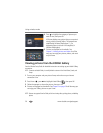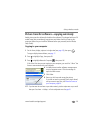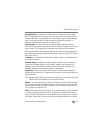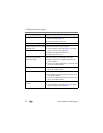
Using wireless mode
www.kodak.com/go/support
33
Encryption key—An alphanumeric (letters and/or numbers) series that enables
data to be encrypted then decrypted so it can be safely shared among members of a
network. WEP uses an encryption key that automatically encrypts outgoing wireless
data. On the receiving side, the same encryption key enables the computer to
automatically decrypt the information so it can be read.
Infrastructure—A client setting for a local area network that allows devices
connected to the network to communicate with one another through a central access
point or router. This configuration is commonly used in wireless home networks.
IP—Internet Protocol: technology that supports voice, data and video transmission
via IP-based local area networks, wide area networks, and the Internet. This includes
VoIP (Voice over IP).
IP address—A number that identifies each sender or receiver of information that is
sent across the Internet.
Network name—Identifies the wireless network for all the shared components.
During the installation process for most wireless networks, you must enter the
network name or SSID. Different network names are used when setting up your
individual computer, wired local area network, or workgroup.
Passphrase—A text string used for WPA security on a Wi-Fi wireless network. A
passphrase may contain up to 31 alphanumeric characters, including spaces and other
special characters.
NOTE: A passphrase used for WPA security is not the same as a WEP key, nor is it the same as a passphrase
commonly found in router software that is used to generate a WEP key.
Router—An access point (AP) or hub that sends data from one local area network
(LAN) or wide area network (WAN) to another. A router monitors and controls data
flow and sends information using the most efficient route based on traffic load, line
costs, speed, bad connections, etc.
SSID—Service Set Identifier: also referred to as a network name, since it is essentially
a name that identifies a wireless network. The identifier is attached to the wireless
local area network (WLAN) and acts as an identifier when a device tries to connect to
the system. A device will not be permitted to join the network unless it can provide


















